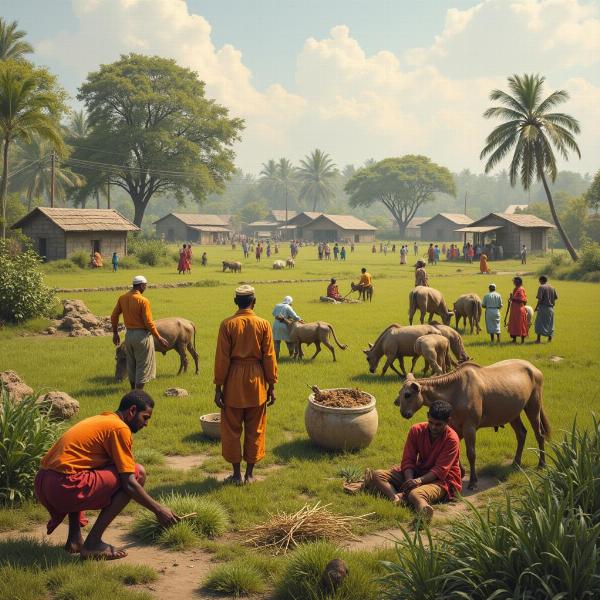Populace meaning in Hindi revolves around the concept of “जनसंख्या” (jansankhya), which translates to “population.” However, “populace” carries a slightly different nuance, often referring to the common people or the masses. Understanding this distinction is key to accurately translating and interpreting the word in various contexts. This article will delve into the different ways “populace” can be expressed in Hindi, exploring its various synonyms, usage in different scenarios, and cultural implications.
Decoding “Populace” in Hindi: Beyond Just Population
While “jansankhya” is a direct translation of “population,” it doesn’t always capture the essence of “populace.” The term “populace” often implies a sense of the general public, the common people, or the masses, especially when discussing social, political, or economic issues. Therefore, using more contextually appropriate terms can enhance clarity and precision.
Exploring Synonyms and Usage: A Deeper Dive
Several Hindi words can effectively convey the meaning of “populace” depending on the specific context:
- आम जनता (Aam Janta): This is perhaps the most common and accurate translation, directly referring to the “common people.”
- जनता (Janta): This term simply means “public” and can be used interchangeably with “aam janta” in many situations. You might find this term used in news articles, for example.
- लोक (Lok): This word translates to “people” and is often used in a more literary or formal context.
- प्रजा (Praja): This term, meaning “subjects,” carries a slightly archaic connotation and is generally used in historical or political contexts.
Consider this example: “The populace was unhappy with the new tax laws.” Translating this as “आम जनता नए कर कानूनों से नाखुश थी” (Aam janta naye kar kanoonon se nakhush thi) accurately reflects the sentiment.
Cultural Context: The Indian Populace
Understanding the Indian populace requires acknowledging its diversity, encompassing various languages, religions, and socio-economic backgrounds. This multifaceted nature influences how the term “populace” is perceived and used. For instance, referring to the “rural populace” implies a distinct set of characteristics and challenges compared to the “urban populace.”
 Rural life in India
Rural life in India
“Populace Meaning in Hindi”: Addressing Specific Questions
What if someone searches for “populace meaning in Hindi” in the context of a specific field? For instance, in a legal document, “populace” might be better translated as “जनता” (janta) to maintain formality. Similarly, in a literary work, “लोक” (lok) might be more appropriate. Understanding the nuances of each term is crucial for accurate translation.
Populace in Political Discourse: A Case Study
The term “populace” frequently appears in political discussions. In Hindi, this context often requires a nuanced understanding of the intended meaning. For instance, a politician addressing the “populace” might be referring to the “जनता” (janta) or “आम जनता” (aam janta) to connect with the common people.
Conclusion: More Than Just a Word
Understanding “populace meaning in Hindi” requires going beyond a simple dictionary definition. It involves appreciating the subtle nuances, cultural context, and intended meaning behind the word. Whether you’re translating a document, interpreting a speech, or simply engaging in a conversation, choosing the right Hindi equivalent ensures accurate and effective communication.
FAQ
- What is the most common Hindi translation for “populace”? The most common translation is “आम जनता” (aam janta).
- When should I use “लोक” (lok) instead of “जनता” (janta)? “लोक” is generally preferred in more literary or formal contexts.
- Does the cultural context affect the meaning of “populace” in Hindi? Yes, the diverse nature of the Indian populace influences how the term is perceived and used.
- What is the difference between “populace” and “population” in Hindi? While “jansankhya” means “population,” “populace” refers to the common people or masses.
- How is “populace” used in Indian political discourse? It is often used to refer to the “janta” or “aam janta” to connect with the common people.
- Can I use “praja” to translate “populace”? It carries an archaic connotation and is usually reserved for historical or political contexts.
- Where can I find professional Hindi translation services? Meaning-Hindi.in offers expert Hindi translation services for various needs.
Meaning-Hindi.in is your one-stop solution for all your Hindi translation needs. We offer a range of services, from business and legal document translation to website localization and technical manual translation. Our team of expert linguists ensures accuracy, cultural sensitivity, and timely delivery. Contact us today at contact@meaning-hindi.in or +91 11-4502-7584 for a free quote. Meaning-Hindi.in is dedicated to bridging the language gap and fostering effective communication.